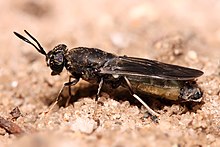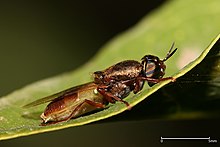Stratiomyidae
| Soldier flies | |
|---|---|
 |
|
| Hermetia illucens | |
 |
|
| Odontomyia sp. | |
| Scientific classification | |
| Kingdom: | Animalia |
| Phylum: | Arthropoda |
| Class: | Insecta |
| Order: | Diptera |
| Suborder: | Brachycera |
| Infraorder: | Stratiomyomorpha |
| Superfamily: | Stratiomyoidea |
| Family: |
Stratiomyidae Latreille, 1802 |
| Subfamilies | |
The soldier flies (Stratiomyidae, sometimes misspelled as Stratiomyiidae, from Greek στρατιώτης - soldier; μυια - fly) are a family of flies (historically placed in the now-obsolete group Orthorrhapha). The family contains over 2,700 species in over 380 extant genera worldwide. Adults are found near larval habitats, which are found in a wide array of locations, mostly in wetlands, damp places in soil, sod, under bark, in animal excrement and in decaying organic matter. Stratiomyinae is a different sub group that tends to have an affinity to aquatic environments.They are diverse in size and shape, though they commonly are partly or wholly metallic green, or somewhat wasplike mimics, marked with black and yellow or green and sometimes metallic. They are often rather inactive flies which typically rest with their wings placed one above the other over the abdomen.
In English, the Stratiomidi are commonly called soldier flies, in German waffenfliegen ("armed flies"). In the Italian language Duméril (1832) used the common names term "stratiomidi" and "mosche armate" in the Dizionario delle Scienze Naturali (Dictionary of Natural Sciences).
Very small to large (3–20 mm long); 3 segmented antennae with the terminal segment annulated; ocelli present; lower orbital bristles absent. post-vertical orbital bristles absent; vibrissae absent; mouthparts - proboscis short, not piercing, maxillary palps 1 or 2 segmented; wings with a small discal cell or discal cell absent, nosub-apical cell, closed anal cell, costa not extending around the entire wing, sub-costa reaching the costa independently of vein 1, or joining vein 1 close to where it joins the costa; the leading edge veins often markedly stronger than the rest; vein 6 present and reaching the wing margin. Vein 7 present not reaching. Tibiae without spurs. For a pictorial atlas explaining these terms go to [1]
Ptecticus elongatus Lateral view
Ptecticus elongatus Dorsal view
Stratiomyidae wing veins
Larvae may be either aquatic or terrestrial. In regards to nutrition they may be saprophagous, mycophagous, or predatory. The larva is apodous and eucephalic and cylindrical-fusiform, depressed dorso-ventrally and distinctly segmented. The size of the mature larva is variable, depending on the species, from less than 1 cm in length up to 3–5 cm. The head is much narrower than the thorax and partially sunken into it. The integument is strongly sclerotized with the cuticle containing inclusions of calcium carbonate with hexagonal crystals which form a characteristic micro-sculpture. In aquatic species, the last urite is thin and more or less elongated forming a breathing tube which ends with a tuft of waterproofing bristles. It is used to draw air from the surface, the larva remaining submerged.
...
Wikipedia
